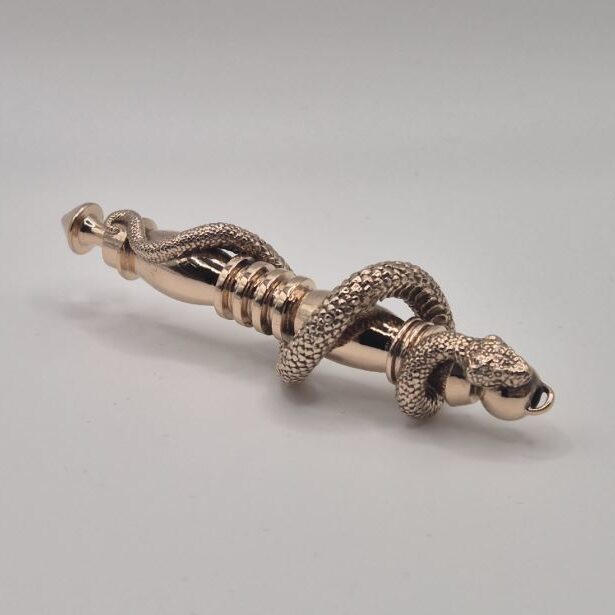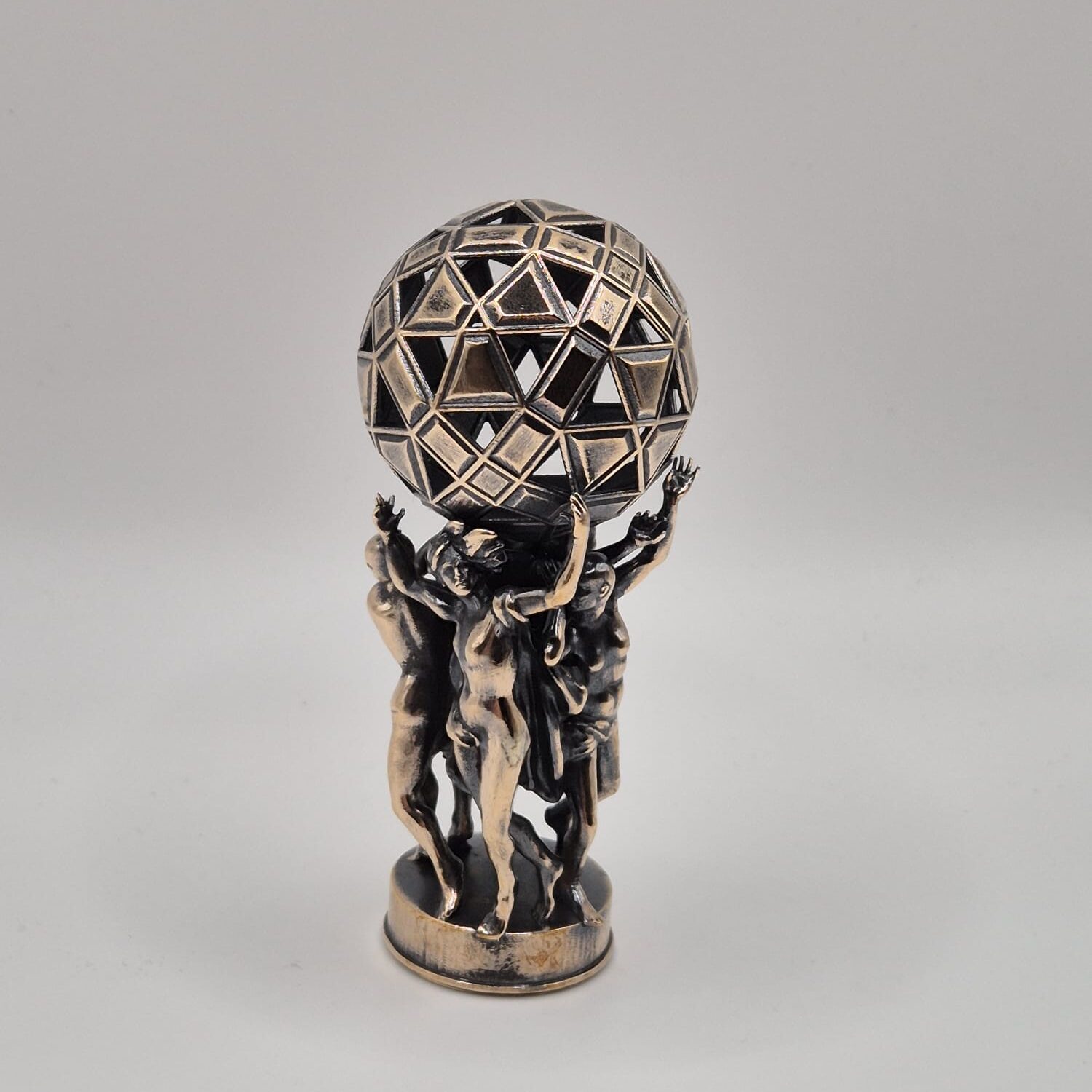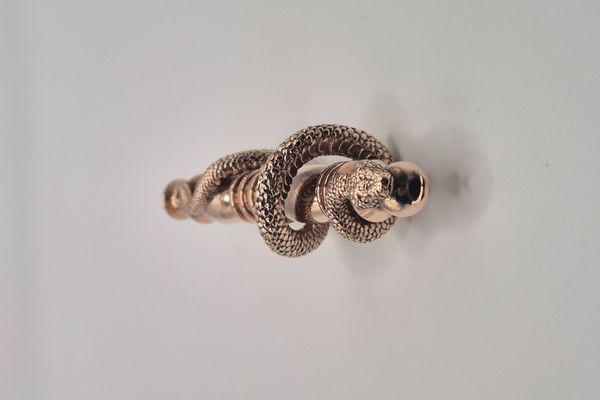
Properties of Bronze
| Color: | Reddish-brown to golden |
| Hardness (Mohs): | ~3.0-4.0 Mohs (depending on composition) |
| Melting Point: | 950–1050 °C |
| Tensile Strength: | 300–550 MPa |
| Density: | ~8.8 g/cm³ |
Why Bronze Is Ideal for Lost Wax Casting
Bronze is a robust material with exceptional casting behavior. It flows easily into detailed molds and hardens without significant deformation or porosity when processed correctly. Its high strength and dimensional accuracy make it suitable for both artistic and practical objects.
Casting Advantages:
High strength after cooling
Ideal for bold, defined shapes and textures
Holds fine detail and surface features
Offers a rich patina over time
Excellent corrosion resistance, even in marine environments
It is ideal for creators who value longevity, warmth, and traditional aesthetics. Whether you’re designing jewelry, historical replicas, custom belt buckles, or personalized objects with character, bronze is a powerful and reliable choice.




Hardness & Strength
Bronze is harder and stronger than brass. Like brass, its Mohs hardness is around ~3.0, but in practical terms bronze is more resistant to scratches and wear. It has greater tensile strength due to the tin content, making it less easy to bend. However, this comes with slightly less ductility: bronze can be a bit brittle . In jewelry, bronze pieces will generally scratch less and hold up to abuse better. It’s an ideal choice where maximum durability is desired: for example, a heavy bronze ring or bracelet that takes a beating will often fare better than a brass one.
Corrosion & Tarnish
One of bronze’s standout features is its corrosion resistance. Bronze is highly resistant to rust and corrosion, even in harsh conditions. Historically it’s used in ship propellers and outdoor sculptures because it withstands saltwater and weather exceptionally well. When bronze oxidizes, it forms a protective patina layer (often an attractive green or deep brown). This patina actually shields the underlying metal from further corrosion. So while bronze will tarnish/oxidize, the result is usually a stable, desirable finish rather than flaky corrosion. Many bronze jewelry pieces intentionally develop an aged look; the patina is considered part of bronze’s charm. Bronze disease – a form of corrosion – can occur under certain conditions, but in normal jewelry wear this is rarely an issue as long as the piece is kept dry and clean.
Hypoallergenic?
Bronze is mainly copper-based and typically contains no nickel, so nickel allergy is not a concern. That said, bronze can also leave green marks on skin due to copper content (the effect is similar to brass, as copper oxidizes with skin salts). If you have a copper sensitivity, bronze might cause some skin irritation or discoloration. Some modern “jewelry bronze” alloys add a bit of nickel for strength or color. If so, those could provoke nickel allergies. In general, assume bronze jewelry may behave like brass in terms of skin reactions: harmless greenish staining is common in humid conditions, and true allergic reactions are uncommon but possible for sensitive individuals.
Everyday Use
Bronze jewelry is exceptionally durable for daily wear. Its hardness means it resists scratches and dings better than softer metals. Large bronze pieces (cuffs, belt buckles, thick rings) can handle rough handling. Over time, expect the piece to darken or develop verdigris patina in recesses. Many find this aesthetically pleasing. If you prefer bronze shiny, you’ll need to polish it periodically (bronze can be polished to a warm golden-brown gleam). Because bronze doesn’t “rust” per se, old bronze jewelry often survives decades or centuries (archaeological bronze artifacts attest to this longevity). Weight is notable: bronze is quite dense, giving jewelry a substantial heft. Some wearers love that solid feel, though very large bronze earrings, for example, might feel heavy.
Care & Maintenance
Cleaning: Use mild soap and water, avoid acidic or abrasive substances.
Polishing: Use a soft cloth or bronze polish. For antique finishes, avoid polishing treated areas.
Storage: Store in a dry place, ideally wrapped in soft cloth to avoid scratches.
Long-term wear: Some patina is natural. A polishing cloth or professional cleaning can restore shine.
Design & Casting
Bronze has a slightly higher melting point (~950 °C) than brass but still casts very well. It was the classical choice for casting fine details in sculpture; likewise in jewelry it captures intricate details nicely. Because bronze is harder, very thin elements (like fine filigree or thin prongs) in a cast can be more brittle: they won’t deform as easily as brass but could snap under stress. Designers often utilize bronze for bold, structured pieces that benefit from its strength (thick rings, armor-like bracelets, etc.). Bronze’s earthy color and patina suit vintage and rustic styles. Example uses: historical-inspired or mythological jewelry often uses bronze for an antique look. It’s also seen in high-end costume pieces, statement pendants, and men’s rings where durability is key.
Designer Tip 💡
Leverage bronze’s strength by using it for pieces that need to endure wear and tear, e.g. a chunky bronze signet ring will hold up well. However, avoid ultra-thin, delicate elements; bronze can be brittle if cast too thin. Aim for a similar minimum thickness of ≥0.8 mm for wires or prongs to ensure the piece isn’t fragile. If your design has fine tips or corners, remember bronze is less forgiving of bending. Consider slightly rounding sharp corners to reduce risk of stress fractures. Bronze can be sealed with a clear lacquer to maintain its initial color, or you can let it patina naturally (which many designers and customers appreciate). For pieces like rings that touch skin, a thin clear coat on the inside or regular cleaning can prevent green finger syndrome. Finally, note that bronze’s hardness can make finishing (sanding, filing) a bit more laborious than other materials. Therefore, use proper tools and plan for that when designing very detailed surfaces.
Bronze Surface Finishes Available at Castimize
We offer a selection of bronze finishes to match your design intent:
Natural Bronze:
Soft matte with visible casting texture; achieved through tumbling only.Polished Bronze:
High-gloss finish produced by hand or mechanical polishing.Antique Bronze:
Patinated finish with deep shadows and highlighted relief; ideal for engraved or embossed details.Nano-Coated Bronze:
Transparent layer that protects against early tarnish or oxidation.
Ready to create in Bronze? Upload your 3D Design
Custom metal casting in gold, silver & more.
High quality, fair prices, worldwide shipping. 🌍

FAQ
Why choose bronze for casting?
Bronze is a classic casting material, used for thousands of years due to its excellent fluidity and durability. It fills molds well, supports fine details, and offers a timeless, earthy aesthetic ideal for sculpture, heritage jewelry, and high-contact items.
Is bronze hypoallergenic?
No. Bronze contains a high percentage of copper, which can react with skin. While not everyone is sensitive, some people may experience green staining or mild irritation. It’s best to avoid bronze for pieces that rest directly on skin for long periods.
Does bronze tarnish or corrode?
Yes, bronze naturally oxidizes when exposed to air and moisture, forming a surface patina that ranges from brown to green (copper carbonate). This is part of its charm for many designers—but if you prefer a clean finish, regular polishing or protective coatings can help.
How does bronze compare to silver or gold in jewelry?
Bronze is much harder and more durable than silver, but not as prestigious or hypoallergenic. Compared to gold, it’s significantly more affordable and rugged. It’s a favorite for bold, rustic designs—but not suited for fine-wear or allergy-sensitive clients.
Can bronze be polished?
Absolutely. Bronze takes on a beautiful shine when polished, especially with a high-gloss finish. However, if left uncoated, it will gradually darken. Some users prefer this antique look—others re-polish regularly to keep the shine.
Explore Materials
- Gold Casting Guide
- Silver Casting Guide
- Brass Casting Guide
- Bronze Casting Guide
- Plated Brass Guide
- Platinum Casting Guide

